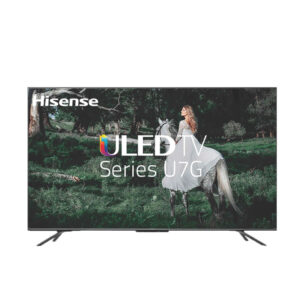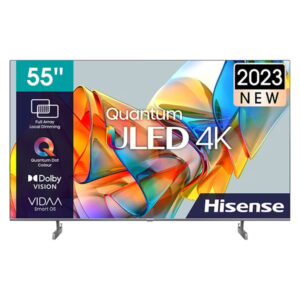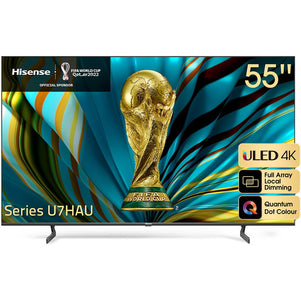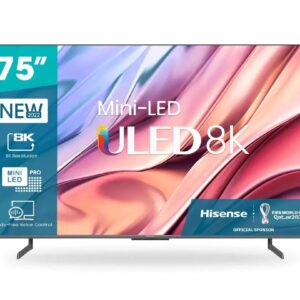ULED
So what’s ULED then? Well unlike OLED it’s not actually a single technology. ULED, or Ultra LED, is the term Hisense uses for a collection of 20 different patents around four key areas: Ultra Wide Colour Gamut, Ultra Local Dimming, Ultra 4K Resolution, and Ultra Smooth Motion Rate. As the name suggests, this is an LED TV technology, but those propriety patents all work to enhance the viewing experience at home.
Colour
ULED TVs have a wide palette and are capable of reproducing a really broad array of colors for images that look brighter and more detailed. Without getting into the heavy terminology or too many numbers, the current industry requirements for the Ultra HD Premium standard require a TV to be able to display 90 percent of the colours defined by something called the DCI-P3 — the U7G ULED TV can display 99.98 percent.
Dimming
As mentioned before, OLED achieves blacks by simply turning off pixels. ULED uses something called local dimming instead. The panel on the U7A is divided into many different zones, each of which can be dimmed and brightened independently of the others. This allows for a very good contrast range as well as great detail when it comes to shadows.
Resolution
All ULED TVs are 4K Ultra High-Definition when it comes to the screen resolution. That’s a resolution of 3,840 x 2,160 (sometimes called 2160p). That’s four times the number of pixels compared to a Full HD TV. With the right 4K content, this means a sharper and more detailed image than you’ve ever seen before. OLED doesn’t have a specific resolution tied to the technology — we’ve seen both 4K and Full HD OLED TVs recently.
Motion
ULED TVs all use a system called UltraSmooth Motion, which is basically a clever algorithm for the TV to create and insert frames into a video, making for smoother transitions. This gets paired with something called Backlight Scanning and the end result is that your fast action films don’t look blurry, and brighter objects can move through dark backgrounds without getting that distracting ‘halo’ effect.
This is just scratching the surface when it comes to both QLED and ULED — there’s a lot of very smart, very high-tech wizardry that goes into both. But hopefully, when you’re looking for your next TV, you’ll be armed with a little bit more knowledge when it comes to the fast-moving world of TV technology
What to focus on when choosing a quantum dot TV
Optimum viewing distance and screen size
When selecting the TV size, consider how far you sit from the receiver and what you are planning to watch there.
| Screen size (1″= 2.54 cm) / What you watch most often | SD programs, DVD movies* | HD programs, Blu-ray movies* |
| 40″- 50″ (about 100-127 cm) | 30 to 3.7 m | 1.5 to 2 m |
| 55″- 65″ (about 140-165 cm) | 4 to 4.8 m | 2.2 to 2.6 m |
| 75 “- 100” (about 191-254 cm) | 5.6 to 7.5 m | 3 to 4 m |
Panel refresh rate
- 50Hz panel– common in cheaper TVs. Compared to a 100 Hz panel it results in less smooth and sharp images in dynamic scenes.
- 100Hz panel– offers crisp and smooth images in the most frantic scenes. The difference compared to a 50Hz panel is particularly noticeable when watching action movies or sports.
TV tuner type
- DVB-S/S2– tuners for receiving satellite television broadcasts.
- DVB-C– cable TV tuner.
- DVB-T– tuner for digital terrestrial broadcasting. This standard is gradually being phased out in some countries.
- DVB-T2 + HEVC– tuner for digital terrestrial TV broadcasting compatible with the newer broadcast standard. The countries that are phasing out DVB-T are switching to this.
Useful features and functions
- WiFi is a wireless technology for connecting your TV to a home network and the Internet.
- Use Bluetooth to wirelessly connect a soundbar, speakers, headphones, keyboard, or mouse to your TV.
- AUSB port allows you to connect an external storage device, keyboard, or mouse.
- With Miracastyou can wirelessly display photos or play videos from your phone and tablet on your TV.
- UseWiDi to wirelessly view pictures, play videos or display the notebook desktop on your TV.
- The PIP/PBP/POPfeatures let you watch two TV stations at once.
- TheCI slot lets you insert a smart card and connect your TV with a satellite or cable television outlet directly, without having to purchase a set-top box.
- Use PVR(Personal View Recorder) to record a movie or TV show on a USB disk or flash drive. If your TV has a dual tuner, you can record one TV station and watch a different one at the same time.
Where to buy Hisense TV?
- Hisense Smart TV Prices Online at Best Price in Kenya at Hisense Kenya
- You cannot add "Hisense 65U6G 65 inch 4K ULED Smart TV" to the cart because the product is out of stock.
ULED TVs
Showing all 4 results



